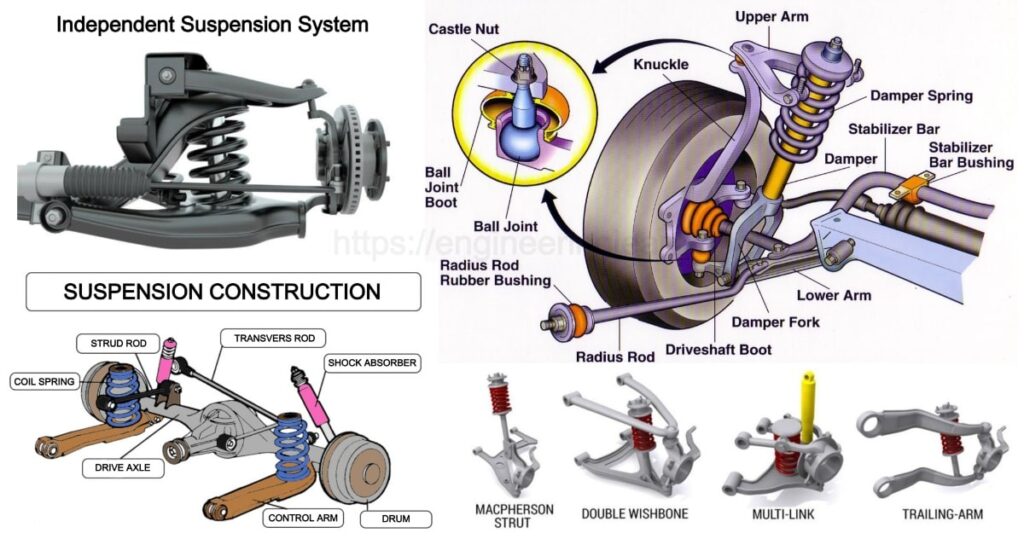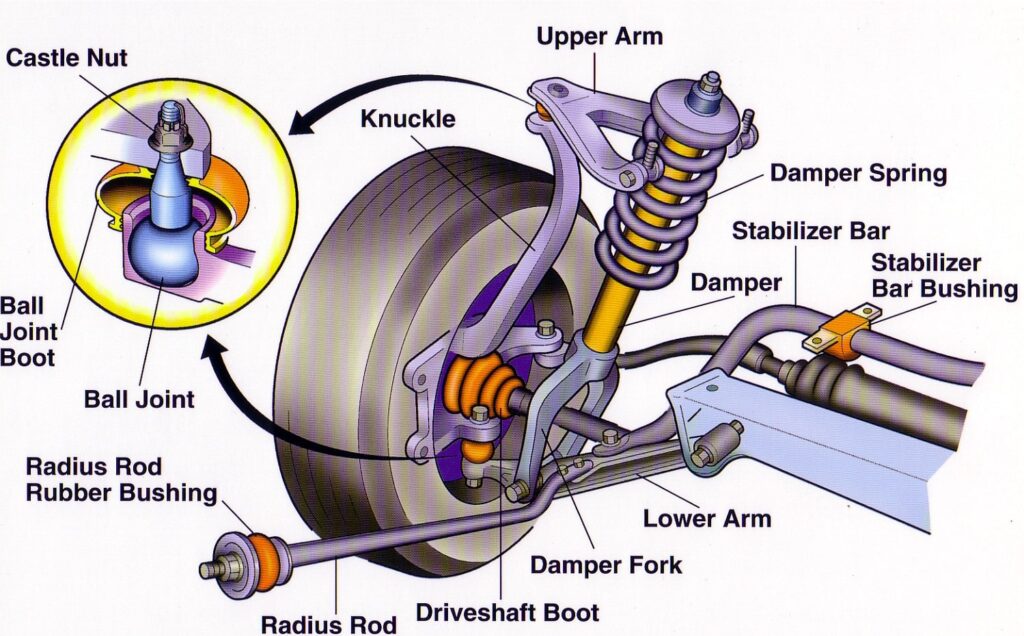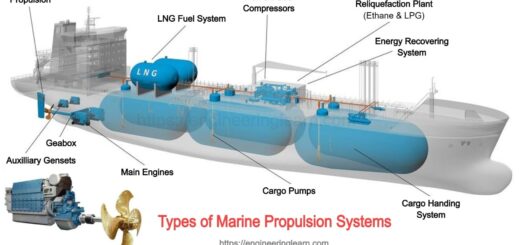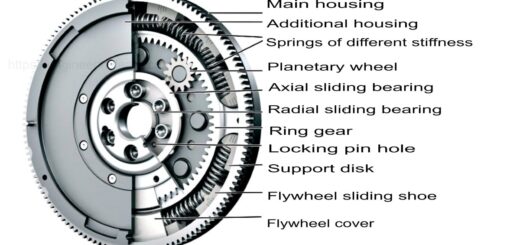Suspension System Types & Components [Complete Guide]

What is Suspension?
Suspension System Types & Components :- The suspension system of a vehicle isolates the wheel section from the body. All the power which is generated from the engine is finally transmitted to the wheel through the power transmission system. With this power, the vehicle moves on the road. The irregular roads the cause of shocks on the wheel and at this point the suspension system acts more as a filter to screen out of the vehicle. The main function of the suspension system is to separate the vehicle body or frame from shocks and vibrations due to bad driving roads.
Good Suspension System
A good suspension system is one that absorbs all the shocks and vibrations due to bad driving conditions and transmits as small a component of shocks and vibrations as possible to the passenger carriage. Springiness is elastic resistance to a load. On application of a sudden load, the spring system will be in compression or expansion as the case may be without transmitting the same to the body. As the spring compresses it absorbs energy and dissipate in form of heat energy and when it expands it rebounds.
Hence the main objective of a good suspension system is to separate the structure, as much as possible, from shock loading and vibrations due to the irregularities of the road surface. This is achieved by flexible elements like springs and dampers. Another function of the suspension system is to achieve the main function without compromising the stability, steering, or general handling qualities of the vehicle. This is done by controlling, by the use of mechanical linkages.
Components of Suspension System

- Knuckle or Upright
- Linkages
- Wheels/tyres
- Dampers/Shock Absorbers
- Springs
- Struts
- Anti Sway Bars
- Ball Joints
- Spindle
1. Knuckle or Upright: ( Components of Suspension )
This is used to connect the wheels to the suspension system. It is mounted on the wheel’s hub. The suspension system is connected together with the linkages provided. The knuckle is having a caster angle and a king-pin on the front wheels which helps in steering of vehicle in left or right direction.
2. Linkages: ( Components of Suspension )
Linkages are like frame of suspension system. All the parts of suspension system are connected together with the help of linkages. These linkages have universal joints on their both ends which help in smooth connection between different components.
Generally there are 3 types of linkages present in the suspension system which are as follows:-
A) Wishbones or A-arm
It is a solid linkage which connects the frame of body and the wheel hub. It is in the shape of alphabet A. The top end of A arm is attached to knuckle which is mounted on wheel hub and rest of the two ends are attached to the frame of body. Depending on the requirement double A-arm can be used.
B) Solid axle or live axle
It is the main axle of the tyres. It connects the main body of the vehicle with knuckle of the tyre. Whole weight of the body lies on this solid axle. The suspension system is mounted on this axle between body and the axle. This is commonly used in heavy duty vehicles.
C) Multiple links
This is the most commonly used in cars. In this multiple small linkages are used in place of wishbone arm and solid axle. By the help of these multiple links knuckle, frame and suspension system are connected together.
3. Wheels/ Tyres: ( Components of Suspension )
Wheel or tyres are those components of suspension system which comes in contact with the actual irregularities of road. Wheels are the main components of automobile as well because they are eventually responsible for motion of automobile. When wheels come across surface irregularities of road they move up and down. This up and down motion causes the actual vibration in the body. To eliminate these vibrations suspension system is placed between body and wheels. The suspension system absorbs the vibrations and helps in comfort ride.
4. Dampers/Shock Absorbers: ( Components of Suspension )
Shock Absorber :- Dampers are used to absorb the vibration and dissipate it in form of heat energy. In damping action energy is converted from one form or the other. In old days, the friction effect between two surfaces is used as a damping agent. Semi rotary vane-type dampers were also used. However, they were abandoned because the ratio of sealing length around their vanes to the volume displaced was so high that these units were rapidly adversely affected by wear.
In Modern cars mostly following two types of hydraulic dampers are used:
• Telescopic dampers
• Rocking lever dampers.
1. Telescopic Damper
Telescopic dampers are quite often called incorrectly shock absorbers. In telescopic dampers, the piston–cylinder arrangement is there. In this system, hydraulic fluid flows past the pistons and fluid absorbs the shocks and vibrations.
2. Rocking Lever Damper
Rocking lever dampers works on the principle same as telescopic dampers. But in this case, a two-piston is used inside the single-cylinder, and oil is displaced through the valve. The movement of the dual pistons takes place due to the motion of the wheels which is moved onto the pistons into the rocker levers.
5. Springs: ( Components of Suspension )
Springs act as reservoirs of energy. Springs store the energy when impact force which acts when the vehicle passes over irregularities of the road. It compresses the spring. This energy is released when spring expands subsequently and with the help of dampers, thus the energy is converted into heat and the shocks and bounce are absorbed.
When the vehicle hits a bump, the tire is suddenly pushed up. In the case of rigid suspension, the full force will be transferred to the carriage unit and push it up with almost no loss in force in the form of a jerk or bounce. However, when spring is present, the force which acts on the vehicle compresses the spring which absorbs the shock and avoids this from transfer to the vehicle frame.
The important factors which govern the choice of which types of springs used are:
• Overall cost of installation.
• Relative capacity for storing energy.
• Total weight of suspension system.
• Fatigue life.
• Location
The major types of springs that are used are:
• Leaf springs or laminated springs
• Coil springs
• Torsion bars
1. Leaf Springs
Leaf springs are also known as laminated springs because they are basically steel strips that are mounted over one another or laminated with a constant reduction in length. They are also called semi-elliptical springs as they are bent in that form. However, nowadays they are almost straight.
2. Coil Springs
The coil shape is the best energy-storing shape for the given weight and a coil spring stores the energy when force is acted on it twists and stores the torsional energy. Coil springs have the benefit of fitting in a compact area. The life of coil springs is increased by shot peening which increases their compressive strength and reduces and also increases the scratch resistance. The life of the coil spring also depends on the diameter of the wire used and the diameter of the coil shape. The material used also plays an important role in the life of coil spring.
3. Torsion Bars
In the case of torsion bars, a steel bar is used. The steel bars act like spring. It is fixed at one end to the body and with the help of a lever; the movement of the wheel or axle is transferred to the torsion bar in form of torque. As a result, the torsion bar twists and deformation takes place and shear stress is induced. The material properties are responsible to regain the bar’s original shape (i.e. untwisted) hence when the force acts on the torsion bar it twists and untwists which creates a spring effect.
Torsion bars are the bar’s shape structure which is overloaded in torsion during manufacture—to stretch outer layers beyond the elastic limit. As this leaves remaining stress in the external layers, the highest stress under service occurs beneath the surface where it is less likely to begin cracks. This helps to increase the fatigue life. Shot peening is also provided in torsion bars as in case coil spring to increase fatigue life.
6. Strut: ( Components of Suspension )
Strut is main component of suspension system. It is used in MacPherson Strut Assembly. Strut is basically the combination of spring and damper which is having two ends which will be attached to the frame and the wheel. Spring is used to store kinetic energy into potential energy and damper dissipates the kinetic energy into heat energy. Both these components works together to form a strut assembly. The size of spring used in strut depend upon the load capacity of the vehicle.
7. Anti Sway Bars: ( Components of Suspension )
These are also known as anti-roll bars. Anti sway bars play a key role in passenger comfort and vehicle stability to improve performance. Anti sway bars acts as one of the key components in a vehicle suspension system. As the name suggests their purpose is to reduce body roll or sway when operating under cornering conditions.
8. Ball joints: ( Components of Suspension )
Ball joints are the critical components of suspension system. It helps to connect different parts and linkages and allow them to move relative to other linkages. Ball joints consist of a metal housing and stud. The stud is able to swing and rotate within the housing. The grease lubrication is also provided in the socket of ball joint. Inside the housing bearings are provided which can be of metal or plastic. Two ends of ball joints are connected to housing and stud respectively.
9. Spindle: ( Components of Suspension )
Spindle enables to drive forward, backward, turn in both directions and brake. The basic function of a spindle is to allow an axle to rotate. The spindle also helps the vehicle to move in straight line by gearing which is called a castor. The castor is basically a forward and backward inclination that regulates the steering procedure.
Types of Suspension System
1. Dependent Suspension System: ( Types of Suspension System )

As name suggests in dependent suspension system both the wheels on same axle are dependent to each other. In dependent suspension system there is a solid or live axle it allows both left and right wheel to connect together as team. If one side of automobile bends in one direction then other side will also bends in the same direction. This is called dependency. Dependent rear suspension types-
A) Solid Axle Leaf Spring Dependent Suspension System
In this type, leaf springs are used as suspension members. The longest spring in the set-up bends into a circle to form a spring’s eye. This spring’s eye is bolted to the spring hanger and the other end of spring’s eye is attached to the shackle. This shackle allows a change in length of the leaf spring when it bends. Also the shackle includes a rubber bushing which absorbs vibrations and prevents them from reaching the vehicle. The Centre portion of the leaf spring is attached to the rear end axle housing with the help of U-bolts and a rebound clip holds all the springs together.
B) Solid Axle Coil Spring Dependent Suspension System
In this type, the coil springs are seated on pan shaped brackets which are attached to the rear axle. Torque tube drives are also attached to this setup and the coil springs are not subjected to the driving thrust. The shock absorbers present here prevent the vehicle from rolling and the energy stored in the coil springs is greater than the leaf springs.
2. Independent Suspension System: ( Types of Suspension System )
As name suggests, in independent rear suspension each wheel on the axle is independently move vertically up and down under the action of suspension. Many vehicles use the independent rear suspension (IRS). IRS has almost same advantages of the independent front suspension but most important advantage of IRS is that it reduces the unsprung weight of the vehicle. On other hand it has high initial cost and high maintenance cost and the components wear out easily. Independent suspension are mainly of three major types as follows: –
Types of Independent Front Suspension Systems
1. Double wishbone suspension system
2. Single wishbone, i.e. Mac Pherson strut assembly.
a) Double Wishbone Suspension System
In construction, the wheel is mounted on the wheel hub. The wheel hub is provided with two links one is an upper link and the other is a lower link. Both the links are pivoted with the frame of the vehicle. A shock absorber is also placed between the frame and the lower link which consists of a flexible joint. When the vehicle moves on uneven surfaces, its wheel faces shocks, these shocks are transferred to the shock absorber through the lower link.
The shock absorber absorbs the maximum amount of shocks. The upper link is used to maintain the camber of the wheel. This system is complex as well as costly and it requires more space. In this system, it is easy to control wheel motion and tune the camber variation. All parts can be optimized.
b) Mac Pherson Strut Assembly (Single Wish Suspension System)
Earle S. Mac Pherson, an engineer with Ford USA, developed a single wishbone with a telescopic strut-type system in 1947. In this system, on the lower side of the wheel hub lower control arm is located with a flexible joint. On the upper end of the wheel hub, a shock absorber or strut is placed which is also attached with a flexible joint. Both the strut and lower control arm are connected to the frame of the vehicle with a flexible joint. In the whole system, the main component is the strut.
It consists of spring and a damper. When the vehicle comes in contact with the irregularities of the road, the wheel moves up and down on the radius of the lower link. Due to this motion, all the shock is transferred to the strut which absorbs the maximum amount of force. It has relatively simple construction which results in a compact design and cheap. In this system change in camber is very high which results in less handling. So it is not preferred in high-speed cars.
3. Air Suspension System: ( Types of Suspension System )
In the air suspension system air spring is used instead of a mechanical spring. Air spring has a higher load-carrying capacity than mechanical spring. Air spring also has the advantage of variable spring rate by adjusting air pressure which is not possible in the case of mechanical spring. In air spring two ends are provided. One is mounted on the frame and the other is to the swing arm. Three connection lines (pressure line, return line, control line) are also provided for the operation and control.
4. Hydro Elastic Suspension System: ( Types of Suspension System )
In this type of suspension system there is an integrated fluid filled displacer which connects the front and rear wheels on either side of the vehicle. The continuous pitching motion of the vehicle provide uncomfortable ride so the main idea behind this type of suspension is to increase the vehicle’s resistance towards pitching. In hydro elastic suspension a rubber displacer unit is installed between the frame and the suspension linkage. A pipe is used to connect the rubber displacer units on both the front and the rear end. There are two separate pipes on either sides of the vehicle and an anti-freeze liquid is used to pressurize this system.
When car travels on an irregular road and there is a sudden upward movement on the front wheels, at this time the liquid inside the rubber displacer gets displaced and flows along the pipes to the rear unit. Then it moves the diaphragm downwards thereby levelling the car. Thus the tendency of body to oscillate is avoided. The opposite happens when rear wheels run over a bump. Once the wheels descend, the vehicle comes to its normal position. (Suspension System Types & Components)
When cornering car will experience a centrifugal force in case of conventional suspension we can feel the tilt but in case of hydro elastic suspension equal amount of fluid will flow to both the front and rear end thereby providing the same amount of pressure which increases the stiffness of the spring. In case of bouncing when all four wheels deflect, the motion will be resisted and the ride will be stiff thereby reducing the pitching of the car.
Image Source :- Studymateriall, Ingenieriaymecanicaautomotriz, Esearchgate, Newkidscar













